$1Bn Spent On Irrigation For Rajasthan, But Barmer Remains 80% Rainfed
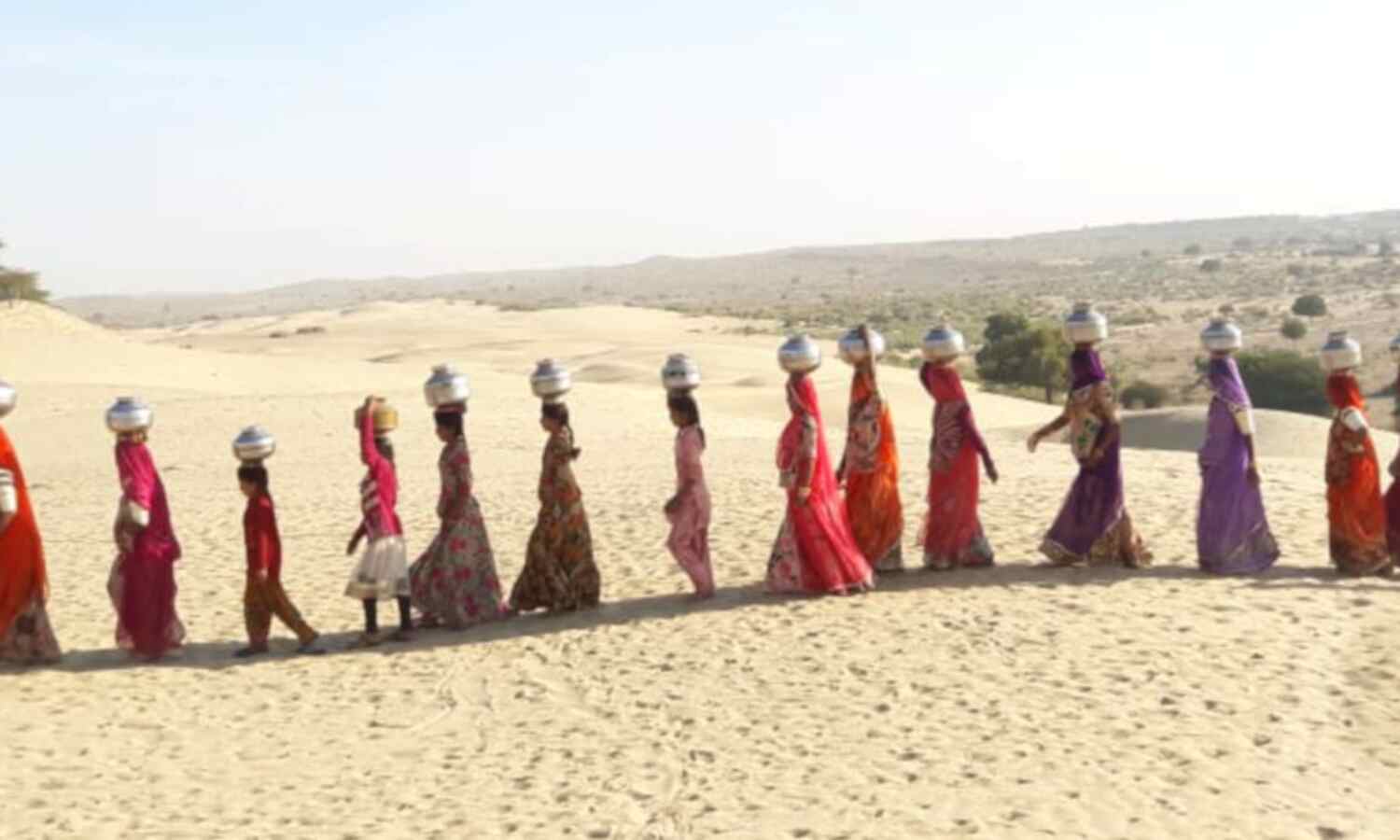
Barmer, Rajasthan: It was March 2019, and Pabusari village in Barmer district in western Rajasthan was parched. Another year of bad monsoon--the fifth--had failed 36-year-old farmer Hariram Meghwal, leaving him with no option but to migrate in search of work to ensure his family's survival.
Meghwal had spent Rs 30,000 on sowing bajra (pearl millet), guar (cluster beans) and moong (green gram) on his six-hectare farm, but drought over successive years had laid it to waste.
Pabusari, about 90 km from the district headquarters, was among the 2,741 villages of Barmer’s total 2,775 to be declared ‘drought-hit’ by the Barmer district administration in 2018, based on a crop assessment report for the last kharif (winter cropping) season.
Meghwal, now working as a driver in Barmer city, said repeated droughts, with the resultant crop damage and financial burden, had spelt doom for farmers across Barmer, particularly as they had received no government support such as alternative employment, fair crop insurance payouts, or timely completion of irrigation projects.
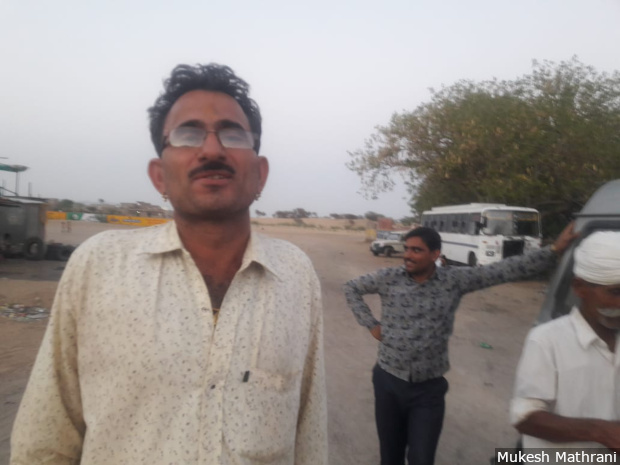
Hariram Meghwal, 36, had spent Rs 30,000 on sowing bajra, guar and moong on his six-hectare farm, but drought over successive years had laid it to waste. Meghwal, now working as a driver in Barmer city in western Rajasthan, says repeated droughts, with the resultant crop damage and financial burden, have spelt doom for farmers across Barmer.
With more than 40% of India’s land area facing a drought and pre-monsoon rains during March and April having fallen short by 27%, this is the fifth story in our series on drought, and has been reported from Rajasthan. The previous stories can be read here, here, here and here. As in other drought-hit parts of the country, prolonged drought in Barmer and other parts of western Rajasthan is forcing farmers to abandon their fields to migrate to cities in search of work and sustenance. There is little help from the government, either in terms of immediate relief or long-term efforts such as completion of irrigation projects on time, farmers told IndiaSpend.
Many farmers we spoke to said since no party in government has been able to ameliorate farm distress, in the ongoing general elections, they would vote by caste or community ties. “We have been facing drought for a long time. When there is no crop, do such promises matter?” said farmer Prahlad Ram of Gadara Road area, now a daily-wage worker, of Prime Minister Narendra Modi’s promise to double farmer income by 2022.
Drought in a desert state
Of Barmer’s total geographical area of 2.82 million hectare, 1.86 million hectare is cultivable. The net sown area is 1.79 million hectare. Of the total cultivable area, about 80% is rainfed, as per a local Krishi Vigyan Kendra (agricultural outreach centre).
In 2014, 1,451 villages of Barmer were declared drought-hit, when the district received 220.79 mm of rainfall against the average of 275 mm. This increased to 2,206 villages in 2015 and 2,478 in 2016.
Rainfall data for the last five years show changing rainfall patterns, and fewer villages were declared drought-hit in 2017--1,925. The average rainfall has since gone up, except in 2018, when 128 mm rainfall was recorded, less than half the average.
This uneven distribution of rainfall is evident nationwide: averages can mask new peaks and lows, as IndiaSpend reported on May 4, 2019.
Pradeep Pagariya, an agricultural scientist at Krishi Vigyan Kendra in Gudamalani in Barmer, explained the paradoxical situation of a drought in a year of more than average rainfall. In 2017, Barmer received 95 mm rainfall in June and 245 mm rainfall in July, but only 18 mm rainfall in August and no rain in September.
More rainfall but for shorter periods is a peculiarity becoming increasingly common--the monsoon period has shrunk from four months to two or even one in some years, Pragariya said, which has sent the largely rainfed crop pattern of the district into a tizzy as it leaves crops damaged during periods crucial for their growth, Pagariya told IndiaSpend.
Complete crop damage in 79% villages
In the 2018 monsoon, as Barmer witnessed 128 mm rainfall against the district average of 275 mm, crops worth Rs 1,200 crore ($173 million) were damaged across the 1.5 million hectare of cultivated land in Barmer.
According to the Barmer district administration’s crop assessment report for 2018, there was 100% crop damage in 2,191 villages in the 2018 kharif season; 503 villages are witnessing 75% crop damage; and 50% of crop damage is reported in the remaining 47 villages.
Farmers allege that crop assessment has been delayed despite continuous drought--the district received no rainfall until August 15, 2018, and crop assessment started only from September 15 and concluded on October 15, after which the report was sent to the state government.
Drought relief activities would commence on April 1, Barmer district collector Himaanshu Gupta told IndiaSpend, adding that the state government would set up cattle camps and fodder depots, and has sanctioned a contingency plan worth Rs 4.50 crore.
To implement this plan, the district administration in the first week of April asked gram panchayats (village councils) and gram sewa sahkari samitis (village cooperatives) to send proposals to set up fodder depots where subsidised fodder would be sold. By April 30, 516 fodder depots had been sanctioned, of which 400 had been opened.
Besides, 16 cattle camps have been opened and another 27 will be set up. Authorities have identified a total of 1,308 areas where severe scarcity of drinking water is observed and people are entirely dependent on government water supply. Water works department has been directed to ensure water supply to these areas through water tankers.
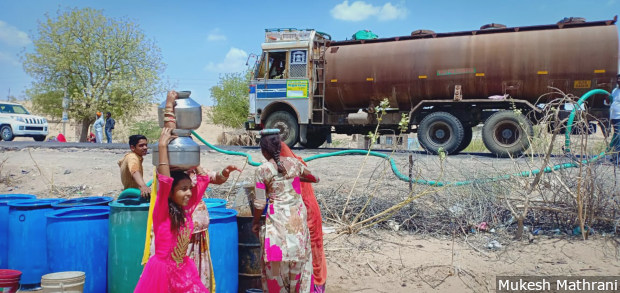
Women in Bhachbhar village, about 45 km west of Barmer city in arid western Rajasthan, collect water supplied by a tanker sanctioned as drought relief.
Government measures not enough
The state government, to compensate farmers for crop damage due to drought, has provided agricultural input subsidy to farmers for the 2018 kharif season with an upper limit of Rs 13,600 for up to two hectares of land. Meghwal said this compensation was not enough to ensure his family’s upkeep, particularly as successive droughts have exhausted his family’s savings and food stores.
In the city, he said, he earns Rs 7,000 a month, of which he sends Rs 5,000 back home. This would not suffice to support his four children’s higher education, once they pass out of the village government school, he said.
Alam Khan, a 46-year-old farmer with 12 hectares of land in Panela village, said he had spent Rs 65,000--gathered through a bank loan and from a moneylender--on sowing bajra and moong. He had received a fourth of this amount, Rs 13,600, as compensation for crop loss from the government. Khan was among the fortunate few who received a loan waiver of Rs 25,000. Yet, continuous drought had forced him to work as a daily wager and two of his three sons to take up driving jobs in Barmer city.
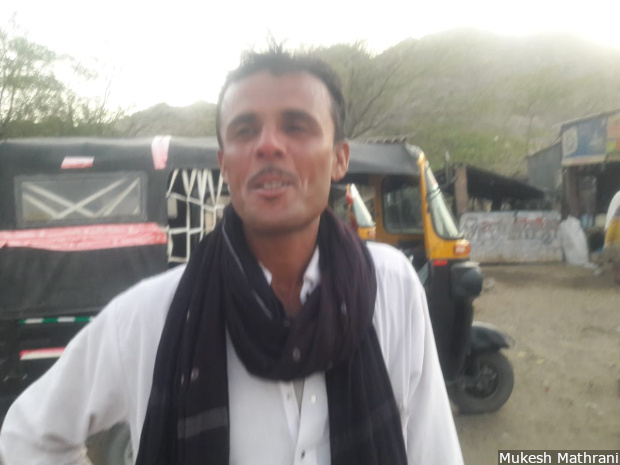
Alam Khan, 46, spent Rs 65,000 on sowing bajra and moong on his 12-hectare farm in Panela village in Rajasthan’s Barmer district. Khan received a loan waiver of Rs 25,000. Yet, successive years of drought have forced him to work as a daily wager and two of his three sons to take up driving jobs in Barmer city.
Smaller farmers such as Babu Ram of Jine Ki Basti and Prahlad Ram of Gadara Road areas said they were forced to borrow from moneylenders to sow crops, since bank loans were not available to them.
Forty-five-year-old Babu Ram said he had received Rs 13,600 as government compensation but had spent Rs 25,000 on cultivating his six-hectare farm. Unable to repay, he had moved to Balotra town to work as a daily wager--earning Rs 300 per day--while his wife tried to find work under the Mahatma Gandhi National Rural Employment Guarantee Scheme (MGNREGS). He said he saved most of his earnings to repay his debt. His two sons were in school.
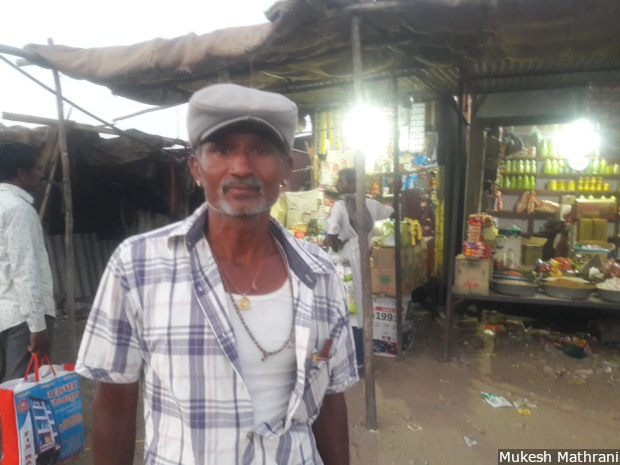
Babu Ram, 45, a farmer with six hectares of land, moved to Balotra town in Barmer district in western Rajasthan, to work as a daily wager, earning Rs 300 per day. His wife takes up the occasional work available under the Mahatma Gandhi National Rural Employment Guarantee Scheme.
Prahlad Ram, too, had turned to daily-wage work to repay the Rs 40,000 he had borrowed to cultivate his seven-hectare farm. He had two children--one studying at the village school and the other working as a driver.
Irrigation projects announced but not completed
Just 20% of Barmer’s farms are irrigated, primarily with tube-wells (63.73%), and some with open wells and canals.
Successive governments over the last six decades have spent more than Rs 7,000 crore ($1 billion) on different water projects to bring canal water to Rajasthan.
The Indira Gandhi Canal Project, conceived in the 1960s and having taken Rs 2,000 crore to bring it to Jaisalmer, is yet to cover Barmer, which is part of its larger plan to provide water to the district along with Ganganagar, Churu and Jaisalmer.
While lack of water and budgetary constraints are cited as reasons why the project was stalled in Jaisalmer, in Barmer, it is the new Desert National Park, spread over 3,612 sq km across Jaisalmer and Barmer, that is acting as a stumbling block, according to veteran journalist Shankarlal Dhariwal, who has covered development projects in the region for many years. Infrastructure projects are prohibited in the vicinity of the park.
Other projects planned to relieve western Rajasthan of its water woes--the Barmer Lift Water Supply project, the Narmada Canal project, Pokhran-Falsund-Balotra-Siwana Lift Project and Ummed Sagar-Dhawa-Khandap-Samdari water scheme--are at various stages of completion.
The Barmer Lift Water Supply project was planned in 1992 to provide water to villages in Barmer and Jaisalmer districts. More than half of the sanctioned Rs 2,203 crore has been spent at various phases of the project. Some of the targeted villages are already benefiting, government officials claimed, while requesting not to be named. Initially due in 2016, the project is now expected to be complete by 2022.
A Narmada Canal project, to connect with the Narmada Valley Project in Gujarat, was conceptualised in 2007 to benefit 1,634 villages across Barmer and Jalore districts at a cost of Rs 2,237.87 crore. Its deadline has been pushed from 2015 to 2020 as work has begun on only the first two phases of the five-phase project, though the canal has started providing irrigation water to some targeted villages.
The Pokhran-Falsund-Balotra-Siwana Lift project was planned in 2005 and Ummed Sagar-Dhawa-Khandap-Samdari water scheme in 2007 at a cost of Rs 1,454.20 crore and Rs 575.46 crore, respectively. While work on the Ummed Sagar-Samdari water scheme is expected to be complete by 2020, the Pokhran-Siwana Lift project has exhausted its allocated funds and is awaiting more from the state government.
| Status of Irrigation Projects In Barmer | |||
|---|---|---|---|
| Project | Amount Allocated | Deadline | Completion Expected by |
| Barmer Lift Water Supply project (1992) | Rs 2,203 crore | 2016 | 2022 |
| Pokhran-Falsund-Balotra-Siwana Lift project (2005) | Rs 1,454.20 crore | 2016 | (indefinite) |
| Narmada Canal project (2007) | Rs 2,237.87 crore | 2015 | 2020 |
| Ummed Sagar-Dhawa-Khandap-Samdari water scheme (2007) | Rs 575.46 crore | 2015 | 2020 |
Source: Public Health and Engineering Department data, Government of Rajasthan
Villagers in these areas told IndiaSpend they continue to depend on traditional water harvesting structures called beris, and open wells, most of which are now claimed by individuals who keep the structures locked and sometimes even paint their names on them to declare ownership.
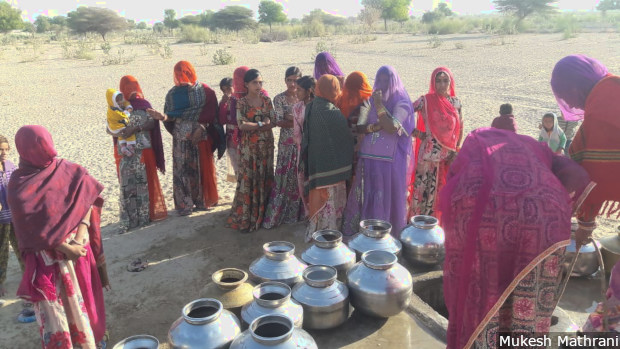
Women in Rohidi village in Rajasthan’s Barmer district collect water from a public well. Most open wells are now claimed by individuals who keep the structures locked and sometimes even paint their names on them to declare ownership.
Almost all the water projects for the region are coming along at a snail’s pace, said T.D. Rathi, a former executive engineer with the public health and engineering department of Rajasthan who currently lives in Barmer. The reason is usually insufficient and non-timely fund allocation, or political meddling. The Barmer Water Lift Canal Project, for instance, was inaugurated by the Congress government in the state in 2003, and expected to be completed by 2007. However, in 2003, the Bharatiya Janata Party (BJP) government on assuming power halted the project for almost four years, only to once again inaugurate work on it in 2007, Rathi said.
Delays deprive the targeted beneficiaries, and lead to cost escalation. In 2003, the Barmer Water Lift Canal Project was expected to cost Rs 425 crore. Now, Rs 800 crore have been spent on its first phase alone, with three phases remaining.
Not enough work under MGNREGS
Nearly 1,100 villages in the district face drinking water shortage, with 200 villages dependent entirely on tankers in the absence of any drinking water source provided by the government, according to a recent report prepared by the revenue department based on a survey it conducted to assess the effect of drought.
Shortage of drinking water and fodder for cattle is one main reason why farmers migrate to neighbouring states such as Gujarat, Madhya Pradesh, Haryana and Punjab in search of work.
Even the provision of an extra 50 days of employment in drought-hit areas against the regular 100 days promised under MGNREGS has not prevented farmer out-migration. Data on the MGNREGS portal reveal that in Barmer, the government has been able to generate 56 days of employment every year on an average over the last five years, as against the promised 100.
In 2018-19, the state government issued job cards to 534,000 households in Barmer but could provide employment to only 306,000 households--a 42% shortfall--while a mere 14,809 or 2.78% of households worked for 100 days. The average wage rate of the past five years in Barmer has been Rs 152.08 per day.
Crop insurance, loan waivers leave farmers unmoved
The government has made efforts to provide drought relief by releasing funds under the crop insurance scheme, rebranded as Pradhan Mantri Fasal Bima Yojana (PMFBY) during Prime Minister Narendra Modi’s tenure, amid claims that farmers would not need to worry about monsoon failure or crop damage anymore.
किसान बहनों-भाइयों आप सब जब लोहड़ी, पोंगल, बिहु जैसे अलग-अलग त्योहार मना रहे हैं, तब सरकार की ओर से एक भेंट - प्रधानमंत्री फसल बीमा योजना।
— Chowkidar Narendra Modi (@narendramodi) January 13, 2016
प्रधानमंत्री फसल बीमा योजना अब तक जितनी योजनाएं थीं उनकी विशेषताओं को तो समाहित करती ही है लेकिन जो कमियाँ थी उनका प्रभावी समाधान देती है।
— Chowkidar Narendra Modi (@narendramodi) January 13, 2016
However, insurance firms in the district have made a practice of releasing a small part of the promised insurance claim, citing late sowing of crops as the reason, state agriculture department officials told IndiaSpend, asking not to be named.
After the 2018 monsoon failed, the insurance firm, TATA AIG Pvt. Ltd, offered to pay only 25% of the Rs 1,034.36 crore (Rs 258.59 crore) claimed by the district administration, according to Kishorilal Verma, deputy director at Agricultural Department in Barmer. This amount was Rs 120.29 crore less than Rs 378.79 crore collected by the company as premium.
TATA AIG said no crops were sown in the district before the August 15 cut-off, so it was liable to pay only 25% of the claimed amount. Deputy Manager for Tata AIG Pvt Ltd in Rajasthan, Shailendra Srivastava, was not available for comment.
Official data reveal that in 2018, 1.52 million hectare of farmland was cultivated, but a bad monsoon damaged crops on 1.22 million hectare and affected 557,000 farmers. Following the report, the state government compensated the losses of 390,000 farmers by issuing Rs 387.60 crore to them as agricultural input subsidy, as per the District Disaster Management and Relief Department. The farmers losing 75% to 100% of their crop got Rs 10,094 on average, those losing 50% to 75% of their crop got Rs 9,373 on average, and the farmers who lost 33% to 50% of their crop got Rs 5,159 on average.
Similar sums were paid out for compensation for crop damage in 2017 and 2016. The compensation is usually just a fraction of the sum farmers have spent, as farmers Babu Ram and Prahlad Ram said.
The state government also opened cattle sheds for livestock and sanctioned contingency plans to supply drinking water by tankers.
Farmers in the state are also entitled to interest-free loans, but continuous drought has kept many of them from paying back previous loans on time. Data accessed by IndiaSpend through sources in cooperative banks showed that around 550,000 farmers were under a combined debt of Rs 2,000 crore in December 2018.
When Rajasthan saw massive farmer protests ahead of the state assembly (legislature) elections in 2018, the then BJP government announced a loan waiver of upto Rs 50,000 to farmers holding up to two hectares of land.
Since a majority of farmers in the region hold five to 10 hectares of land, they did not receive waivers. Taking a cue from this, one of the first decisions of the new Ashok Gehlot-led Congress government that came to power in December 2018 was to waive farmers’ loans of up to Rs 2 lakh each.
During the BJP’s December 2013 to December 2018 term, Rs 415 crore farmer debt was waived in Barmer. The current Congress government’s loan waiver of Rs 683.92 crore is estimated to have benefitted 200,000 farmers in the district.
How will farmers vote?
Despite deep crisis in the farm sector, it is the local issues and caste that decide the elections in Barmer, political analyst Manoj Gujar told IndiaSpend, adding that the national issues or the mass appeal of leaders such as Prime Minister Narendra Modi or Congress president Rahul Gandhi have very little effect on people here.
Barmer voted on April 29 in the ongoing general election. It was untouched by the “Modi wave”, Gujar said, citing the example of the BJP candidate from the district, Col Sonaram Choudhary. The three-time Congress member of parliament switched to the BJP when the latter promised him a ticket, and won the 2014 Lok Sabha polls largely due to the caste-based support he enjoyed, Gujar said. He defeated a BJP-rebel candidate as well as former BJP stalwart Jaswant Singh, who had contested the 2014 Lok Sabha elections independently.
Barmer farmer Alam Khan said he had voted for Jaswant Singh last time, because Singh and his son Manvendra had been helpful to his people and because his community votes as “suggested by our leaders”. Manvendra contested from Barmer on a Congress ticket this time.
Farmer Prahlad Ram, on the other hand, had chosen Choudhary in the last elections because “they belong to the same community”, a criterion he said he used in every election.
Hariram Meghwal said no government has so far been able to sort out farmers’ problems. With the governments and the rain gods repeatedly failing him, Meghwal said he would rather place his trust in his luck.
This is the fifth report of a six-part series in our series on drought, and has been reported from Rajasthan. The previous stories can be read here, here, here and here.
(Mathrani is a Barmer-based freelance writer and a member of 101Reporters.com, a pan-India network of grassroots reporters.)
We welcome feedback. Please write to respond@indiaspend.org. We reserve the right to edit responses for language and grammar.


